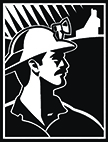
ABOUT the EXHIBIT
Seated on the shores of Lake Superior, Gay, Michigan has transformed the coastline and waters of Big Traverse Bay. Once a lightly traveled region on the eastern Keweenaw Peninsula where Ojibwa harvested wild rice, berries, lake trout, and whitefish, and briefly a late 1800s logging port, it became a copper mill town in 1900 when the Mohawk and Wolverine mines built their mills. In just thirty years these two copper stamp mills deposited a large volume of mine tailings in the bay. The black tailings migrated down shore to the Traverse River, into Lake Superior and covered the vital cobblestone fish spawning grounds of Buffalo Reef. Ninety years later, these tailings, known locally as “stamp sands,” are a hazard and pollutant for wildlife, shoreline residents, and the Ojibwa who depend upon Buffalo Reef for subsistence and commercial fishing. Today federal, tribal, and state governments are working to limit their harm.
This online exhibit, an extension of the interpretive display at the Gay Museum, explores the long history of the Gay landscape, the effects of copper mining and milling, and the story behind the effort to “Save Buffalo Reef.” Mining both shapes communities and leaves behind problems that require perpetual attention. Gay’s legacy provides important lessons that can benefit other communities.
Attribution
This exhibit was funded by a Keweenaw Heritage Grant and
the Keweenaw County Historical Society. This project was made possible
by the skills of Carol MacLennan, Mark Rhodes, Mike Stockwell, Charles
Kerfoot, Emma Wuepper; with help from Nancy Sanderson, Elise Nelson, Tom
Wolniewicz, Duane Coponen, Dick Mintkin, MTU’s Geospatial Research
Facility, and students in Mark Rhodes’s Industrial Communities course:
James Juip, Larissa Juip, Val Pulido.



